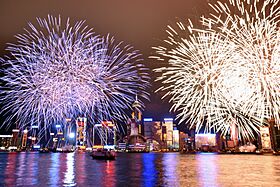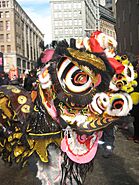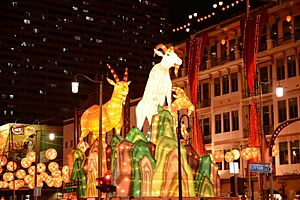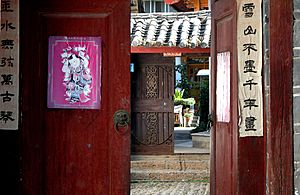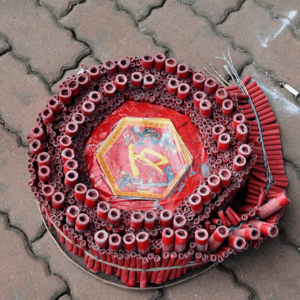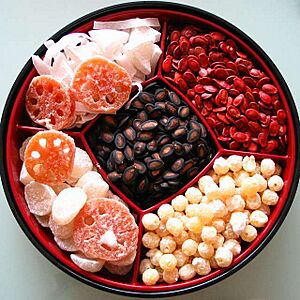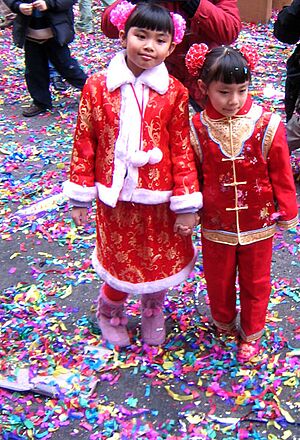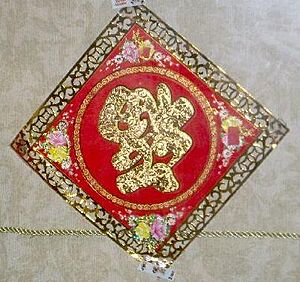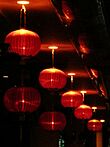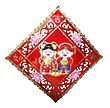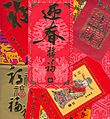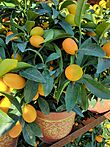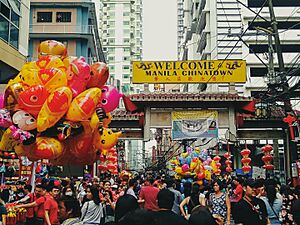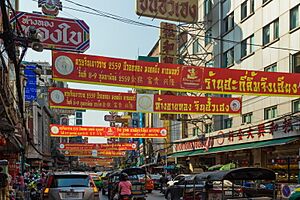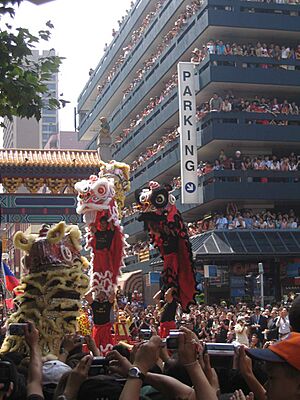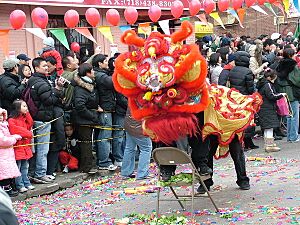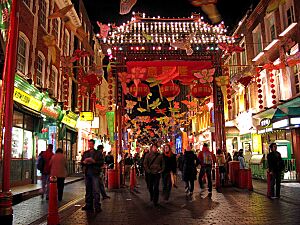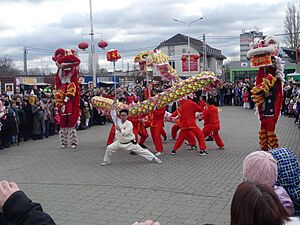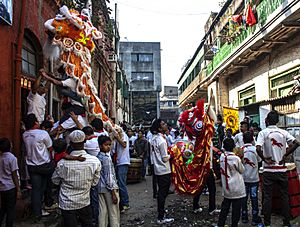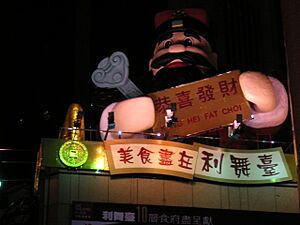Chinese New Year facts for kids
Quick facts for kids Chinese New Year |
|||||||||||||||||||||||||||||||||
|---|---|---|---|---|---|---|---|---|---|---|---|---|---|---|---|---|---|---|---|---|---|---|---|---|---|---|---|---|---|---|---|---|---|
|
Clockwise from the top: Fireworks over Victoria Harbour in Hong Kong; lion dance in Boston Chinatown; red lanterns on display; complex patterns woven at dragon dance in Binondo, Manila; red envelopes; firecrackers exploding; and spring couplet
|
|||||||||||||||||||||||||||||||||
| Also called | Spring Festival | ||||||||||||||||||||||||||||||||
| Observed by | Chinese people and Sinophone communities | ||||||||||||||||||||||||||||||||
| Type | Cultural Religious (Chinese folk religion, Han Buddhist, Confucian, Taoist, some Christian communities) |
||||||||||||||||||||||||||||||||
| Significance | Commemoration of the beginning of a new year on the traditional lunisolar Chinese calendar | ||||||||||||||||||||||||||||||||
| Celebrations | Lion dances, dragon dances, fireworks, family gathering, family meal, visiting friends and relatives, giving red envelopes, decorating with chunlian couplets | ||||||||||||||||||||||||||||||||
| Date | First day of the first Chinese lunisolar month | ||||||||||||||||||||||||||||||||
| 2024 date | 10 February | ||||||||||||||||||||||||||||||||
| 2025 date | 29 January | ||||||||||||||||||||||||||||||||
| 2026 date | 17 February | ||||||||||||||||||||||||||||||||
| Frequency | Annual | ||||||||||||||||||||||||||||||||
| Related to | Lantern Festival and similar celebrations in other Asian cultures | ||||||||||||||||||||||||||||||||
| Chinese name | |||||||||||||||||||||||||||||||||
| Traditional Chinese | 春節 | ||||||||||||||||||||||||||||||||
| Simplified Chinese | 春节 | ||||||||||||||||||||||||||||||||
| Literal meaning | "Spring Festival" | ||||||||||||||||||||||||||||||||
|
|||||||||||||||||||||||||||||||||
| Agricultural Calendar New Year | |||||||||||||||||||||||||||||||||
| Traditional Chinese | 農曆新年 | ||||||||||||||||||||||||||||||||
| Simplified Chinese | 农历新年 | ||||||||||||||||||||||||||||||||
|
|||||||||||||||||||||||||||||||||
| Traditional Chinese New Year | |||||||||||||||||||||||||||||||||
| Traditional Chinese | 中國傳統新年 | ||||||||||||||||||||||||||||||||
| Simplified Chinese | 中国传统新年 | ||||||||||||||||||||||||||||||||
|
|||||||||||||||||||||||||||||||||
Chinese New Year, also known as the Spring Festival, is a special holiday that celebrates the start of a new year. It follows the traditional lunisolar Chinese calendar. This festival is one of the most important holidays in Chinese culture. In 2024, it was added to the Intangible Cultural Heritage list by UNESCO, which is the United Nations group for education, science, and culture.
The festival marks the end of winter and the beginning of spring. It usually lasts from Chinese New Year's Eve until the Lantern Festival, which is on the 15th day of the new year. The first day of Chinese New Year happens on the new moon that appears between January 21 and February 20 each year.
Chinese New Year has many old stories and traditions. People traditionally honored gods and their ancestors during this time. Different parts of China celebrate with their own unique customs. On Chinese New Year's Eve, families gather for a special reunion dinner. People traditionally clean their homes very well to get rid of bad luck and make space for good luck. They decorate windows and doors with red paper-cuts and couplets. These decorations often show wishes for good fortune, happiness, wealth, and a long life. Other fun activities include lighting firecrackers and giving money in red envelopes.
Chinese New Year is also celebrated by Chinese people all over the world. This is especially true in Southeast Asia, like Singapore, Malaysia, and the Philippines. It is also celebrated in places like Australia, Canada, the United Kingdom, and the United States. Chinese New Year has also influenced similar celebrations in other cultures, often called Lunar New Year. Examples include Tết in Vietnam and Seollal in Korea.
Contents
Names for the Celebration
In Chinese, this festival is often called the "Spring Festival" (traditional Chinese: 春節; simplified Chinese: 春节; pinyin: Chūnjié). This name came about because the spring season in the lunisolar calendar traditionally begins around the time of Chinese New Year. The name "Spring Festival" was first suggested in 1914 by Yuan Shikai, who was a leader in China at that time.
The festival is also known as "Lunar New Year" in English. However, the traditional Chinese calendar is actually a lunisolar calendar, meaning it uses both the moon and the sun to track time. Still, "Chinese New Year" is a very common name used by people who are not Chinese. Many different groups within China, and countries like Korea, Vietnam, Singapore, Malaysia, Indonesia, and the Philippines, celebrate it as an official holiday.
When Chinese New Year Happens
The date for Chinese New Year changes each year because it follows the Chinese calendar. This calendar is based on the moon's cycles. The New Year usually falls on the second new moon after the winter solstice. This means it happens between January 21 and February 20 in the Gregorian calendar (the calendar most of the world uses).
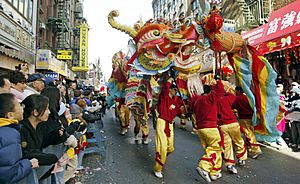
Here are some recent and upcoming Chinese New Year dates:
| Gregorian Date | Animal Year | Day of the week |
|---|---|---|
| 2024 | Dragon | Saturday |
| 2025 | Snake | Wednesday |
| 2026 | Horse | Tuesday |
| 2027 | Goat | Saturday |
| 2028 | Monkey | Wednesday |
| 2029 | Rooster | Tuesday |
| 2030 | Dog | Sunday |
The Story of Nian
An old story says that Chinese New Year began because of a mythical beast called the Nian. This creature lived in the sea or mountains and would come out at night to eat villagers, especially children. One year, everyone decided to hide from the Nian. But an old man appeared and said he would stay and get revenge on the beast.
The old man put up red papers and set off firecrackers. The next day, the villagers returned and found nothing destroyed. They believed the old man was a god who saved them. They learned that the Nian was afraid of the color red and loud noises. So, as New Year approached, people started wearing red clothes, hanging red lanterns, and using firecrackers and drums to scare the Nian away. The Nian never bothered the village again.
History of the Festival
Before the New Year celebration we know today, ancient Chinese people celebrated the end of harvest in autumn. This was different from the Mid-Autumn Festival, which is about worshipping the Moon. A very old poem from the Western Zhou period (1045 BC – 771 BC) describes people celebrating the 10th month of the old solar calendar, which was in autumn. They cleaned up, shared rice wine, cooked meat, and wished each other long lives. This celebration is thought to be an early version of Chinese New Year.
The first records of a Chinese New Year celebration date back to the Warring States period (475 – 221 BC). In the Qin state, a ritual called "Big Nuo" was performed on the last day of the year to get rid of illness. When the Qin dynasty united China, this ritual spread. It later became the tradition of thoroughly cleaning one's house before Chinese New Year.
During the Han dynasty (202 BC – 220 AD), people started celebrating the new year. A book from that time describes families worshipping ancestors and parents. It also mentions children serving special pepper wine to their parents and wishing them good health. This tradition of honoring ancestors on New Year's Eve continues today.
People also began visiting friends and family to wish them a happy new year. During the Jin dynasty (266–420), people started staying up all night on New Year's Eve, a tradition called shousui (守歲). This was described in an old article, which also used the term chuxi (除夕) for New Year's Eve, a term still used.
An old book from the Northern and Southern dynasties describes firing bamboo in the morning of New Year's Day. This made loud noises to scare away evil spirits. A poet from the Tang dynasty also wrote about this.
During the Tang dynasty, people started sending "New Year's greetings" (bai nian tie, 拜年帖). It is said that Emperor Taizong of Tang began this custom by sending gold leaves with good wishes to his ministers. This idea spread, and people started using paper to send greetings to friends.
The Chunlian (Spring Couplets) were first written by Meng Chang, an emperor from the Five Dynasties and Ten Kingdoms period. These couplets are poems written on red paper and hung on doors. This tradition became very popular during the Song dynasty. A famous poet, Wang Anshi, wrote about it in his poem Yuan Ri (元日):
|
爆竹聲中一歲除, |
Amid the sound of firecrackers a year has come to an end, |
| —王安石, 元日 | —Wang Anshi, New Year's Day |
The poem also mentions bao zhu (爆竹, "exploding bamboo"), which refers to firecrackers. After gunpowder was invented in the Tang dynasty, people started putting it in bamboo poles for louder explosions. Later, they used paper to wrap the gunpowder, creating the firecrackers we know today. These are still called bao zhu and are used to celebrate.
During the Song dynasty, people also started giving money to children for the new year. This money was called sui nian qian (随年钱, "money based on age").
The tradition of eating Chinese dumplings jiaozi (餃子) became popular during the Ming dynasty. People would sometimes put silver coins inside dumplings, believing that whoever found the coin would have good fortune. Today, people put other lucky foods inside, like dates for a flourishing year or candy for sweet days.
In the Qing dynasty, the money given to children was called ya sui qian (壓歲錢, "New Year's Money"). This term is still used today. The money was given in red strings of coins or colorful purses.
In 1967, during the Cultural Revolution, official Chinese New Year celebrations were banned in China. However, in 1980, the traditional celebrations were brought back. In 2024, Chinese New Year was recognized by the UNESCO as an Intangible Cultural Heritage.
Public Holiday Status
Chinese New Year is a public holiday in many countries and regions where many Chinese people live. Since the date changes each year, some governments adjust workdays to create a longer holiday. If the New Year falls on a weekend, an extra holiday day is often added. The holiday might be called "Chinese New Year," "Lunar New Year," or "Spring Festival" depending on the country.
For celebrations in other countries that follow Chinese-inspired calendars, like Korea's Seollal or Vietnam's Tết, you can find more information in the Lunar New Year article.
Here are some places where Chinese New Year is a public holiday:
| Country/Region | Official Name | Description | Number of Days |
|---|---|---|---|
| Malaysia | Tahun Baru Cina | The first 2 days of Chinese New Year. | 2 |
| Singapore | Chinese New Year | The first 2 days of Chinese New Year. | 2 |
| Brunei | Tahun Baru Cina | Half-day on Chinese New Year's Eve and the first day of Chinese New Year. | 1 |
| Hong Kong | Lunar New Year | The first 3 days of Chinese New Year. | 3 |
| Macau | Novo Ano Lunar | The first 3 days of Chinese New Year | 3 |
| Indonesia | Tahun Baru Imlek (Sin Cia) | The first day of Chinese New Year. | 1 |
| China | Spring Festival (Chūn Jié) | The eve and first 3 days of Chinese New Year. Extra days are often added, making it a full week known as Golden Week. | 4 (official) 7 (often de facto) |
| Myanmar | Chinese New Year | The first day of Chinese New Year. | 1 |
| Philippines | Chinese New Year | Half-day on Chinese New Year's Eve and the first day of Chinese New Year. | 1 |
| South Korea | Korean New Year (Seollal) | The first 3 days of Chinese New Year. | 3 |
| Taiwan | Taiwanese New Year | Chinese New Year's Eve and the first 3 days. Extra days are added if holidays fall on weekends, sometimes making it 9-10 days. | 4 (legally) 9–10 (including weekends) |
| Thailand | Wan Trut Chin (Chinese New Year's Day) | Observed by Thai Chinese and some businesses. Usually celebrated for three days. It is a public holiday in some provinces. | 1 |
| Vietnam | Tết Nguyên Đán (Vietnamese New Year) | The first 3 days of Chinese New Year. | 3 |
| Japan | Shōgatsu (Japanese New Year) | Celebrated on January 1st of the Gregorian calendar since 1873. | 4 |
| New York, United States | Lunar New Year | The first days of Lunar New Year | 1 |
| California, United States | |||
| Suriname | Maan Nieuwjaar | The first day of Chinese New Year. | 1 |
How the Festival is Celebrated
Red couplets and red lanterns are displayed on the door frames and light up the atmosphere. The air is filled with strong Chinese emotions. In stores in Beijing, Shanghai, Wuhan, and other cities, products of traditional Chinese style have started to lead fashion trend[s]. Buy yourself a Chinese-style coat, get your kids tiger-head hats and shoes, and decorate your home with some beautiful red Chinese knots, then you will have an authentic Chinese-style Spring Festival.
Days Before New Year
About a week before Chinese New Year, on the eighth day of the last lunar month, the Laba Festival is celebrated. A traditional porridge called Laba porridge (simplified Chinese: 腊八粥; traditional Chinese: 臘八粥; pinyin: làbā zhōu) is eaten. This porridge is made with many different ingredients and is sometimes offered to ancestors.
In the days leading up to New Year, Chinese families clean their homes very thoroughly. This is believed to sweep away any bad luck from the past year and make room for good luck. People often paint their doors and windows red and decorate them with paper cutouts and couplets that have good wishes. Buying new clothes and shoes is also common, symbolizing a fresh start. Haircuts are usually done before New Year, as cutting hair on New Year's Day is thought to bring bad luck.
Many families who follow Buddhism or Taoism clean their home altars and statues. Old decorations are taken down and burned, then replaced with new ones. Some people also "send gods back to heaven" (Chinese: 送神; pinyin: sòngshén), like burning a paper image of the Kitchen God. This is done so the Kitchen God can report to the Jade Emperor about the family's good and bad deeds. Families often offer sweet foods to encourage the deities to report good things.
Before the big Reunion Dinner, families often hold a prayer to give thanks for the past year. Some people remember their ancestors, while others offer Christian prayers.
New Year's Eve
The day before Chinese New Year is for the important dinner feast. This meal is a huge family gathering, similar to Thanksgiving or Christmas dinner. It usually includes special meats like pork and chicken, and fish. Many families have a communal hot pot to show everyone coming together.
In northern China, families traditionally make jiaozi (dumplings) and eat them at midnight. Dumplings look like old Chinese money, so they symbolize wealth. In the South, people often make a sticky New Year cake (niangao) and give pieces as gifts.
Some families visit temples before midnight to pray for good luck by lighting the first incense of the year. Many households also have parties. Traditionally, firecrackers were lit to scare away evil spirits. Doors are sometimes sealed until dawn in a ritual called "opening the door of fortune." Staying up late on New Year's Eve is called shousui (Chinese: 守岁) and is believed to help parents live longer.
First Day of New Year
The first day is called the "Spring Festival" (simplified Chinese: 春节; traditional Chinese: 春節). It is a time to welcome the gods of the heavens and Earth at midnight. People traditionally light fireworks and firecrackers, and lion dance troupes perform to scare away evil spirits.
Certain actions are considered bad luck on this day, like lighting fires or using knives, so all food is cooked beforehand. Sweeping, using bad words, or breaking dishes are also avoided.
Families gather at the homes of their oldest relatives, like grandparents, to wish them well. They exchange Mandarin oranges as a symbol of wealth and good luck. Married family members give red envelopes with money, called lai see or hongbao, to younger, unmarried family members. This is a way to give blessings and wish them well for the year. Business owners might also give red packets to their employees. The money usually has even numbers, especially 8 (which sounds like "prosperity"), but not 4 (which sounds like "death").
While fireworks are very popular, some places have banned them due to safety concerns. Instead, large fireworks shows are sometimes put on by governments.
Second Day of New Year
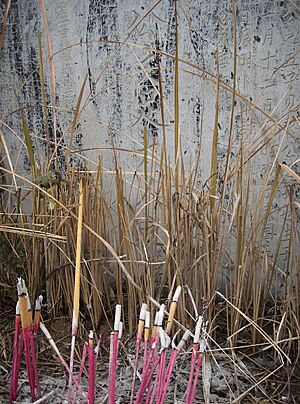
The second day is called "a year's beginning" (simplified Chinese: 开年; traditional Chinese: 開年; pinyin: kāinián). On this day, married daughters visit their birth parents, relatives, and close friends. This helps families stay connected.
People also offer money and sacrifices to the God of Wealth (Chinese: 财神) on this day, hoping for good fortune after any difficulties in the past year. In the past, people would carry pictures of the God of Wealth and shout "Cai Shen dao!" (The God of Wealth has come!). People would then give them "lucky money."
This day is also believed to be The Birthday of Che Kung, a god worshipped in Hong Kong. People visit Che Kung Temples to pray for his blessings.
Third Day of New Year
The third day is known as "red mouth" (Chinese: 赤口; pinyin: Chìkǒu). It is also called "Chigou's Day" (Chinese: 赤狗日; pinyin: Chìgǒurì), named after a god of anger. Some villagers burn paper offerings. It is thought to be an unlucky day for visiting others, so many people stay home. It is also a good day to visit the temple of the God of Wealth.
Fourth Day of New Year
In some places, the fourth day marks when businesses start their "spring dinners" and return to normal work. In other areas with longer holidays, people welcome back the gods who were sent off earlier in the festival.
Fifth Day of New Year
This day is the God of Wealth's birthday. In northern China, people eat jiaozi (dumplings) in the morning. It is also common to set off firecrackers to get the attention of Guan Yu, a Chinese god, hoping for his favor and good luck.
Sixth Day of New Year
On the sixth day, called Horse's Day, people get rid of the garbage that has built up during the festival. This is done to symbolically drive away the "Ghost of Poverty." This tradition shows the wish to leave behind past difficulties and welcome a prosperous new year.
Seventh Day of New Year
The seventh day is traditionally known as Renri, or the common person's birthday. This means everyone becomes one year older on this day. In some Chinese communities in Southeast Asia, people eat a tossed raw fish salad called yusheng for continued wealth and good fortune.
For many Chinese Buddhists, this is a day to avoid eating meat. It celebrates the birth of Sakra, a lord of the gods in Buddhist stories, similar to the Jade Emperor.
Eighth Day of New Year
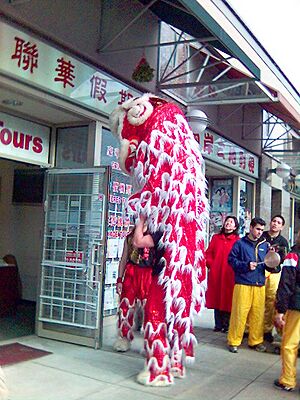
Another family dinner is held to celebrate the eve of the Jade Emperor's birthday, who is the ruler of heaven. Many people return to work by the eighth day. Business owners often host a lunch or dinner for their employees to thank them for their hard work.
Ninth Day of New Year
The ninth day is traditionally the birthday of the Jade Emperor of Heaven (Chinese: 玉皇; pinyin: Yù Huáng). Many people offer prayers in Taoist temples to give thanks. This day is especially important to Hokkiens.
A common offering is sugarcane. A legend says that Hokkien people were saved from pirates by hiding in a sugarcane field on the eighth and ninth days of Chinese New Year, which matched the Jade Emperor's birthday. The word for "sugarcane" (Chinese: 甘蔗; Pe̍h-ōe-jī: kam-chià) sounds similar to "thank you" (Chinese: 感謝; Pe̍h-ōe-jī: kám-siā) in the Hokkien dialect.
Tenth Day of New Year
On this day, the nation continues to celebrate the Jade Emperor's birthday.
Fifteenth Day of New Year
The fifteenth day of the new year is the Lantern Festival, also known as the Yuanxiao Festival (simplified Chinese: 元宵节; traditional Chinese: 元宵節; pinyin: Yuán xiāo jié). On this day, people eat sweet glutinous rice balls called tangyuan (simplified Chinese: 汤圆; traditional Chinese: 湯圓; pinyin: tang yuán). Candles are lit outside homes to guide spirits home. Families often walk the streets carrying lanterns, which sometimes have riddles on them.
In China and Malaysia, this day is also a time for people to look for a romantic partner, similar to Valentine's Day. Single women might write their phone numbers on mandarin oranges and throw them into a river or lake. Single men then collect the oranges. The taste of the orange is said to predict their love life: sweet means good fortune, while sour means less favorable.
This day usually marks the end of the Chinese New Year celebrations.
Traditional Foods
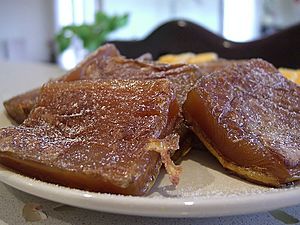
A special reunion dinner is held on New Year's Eve, where family members gather. This meal is usually at the home of the oldest family member. The dinner is very large and includes dishes like pork, chicken, and fish. A communal hot pot is often part of the meal, symbolizing the family coming together. Special meats and seafood like lobster are also common. In most areas, fish (simplified Chinese: 鱼; traditional Chinese: 魚; pinyin: yú) is included but not fully eaten. This is because the Chinese phrase "may there be surpluses every year" (simplified Chinese: 年年有余; traditional Chinese: 年年有餘; pinyin: niánnián yǒu yú) sounds like "let there be fish every year." Eight dishes are often served for good luck, but if there was a death in the family the previous year, seven dishes are served.
Other traditional foods include noodles, fruits, dumplings, spring rolls, and sweet rice balls (Tangyuan). Each food has a special meaning:
- Noodles are usually long and thin, symbolizing a wish for a long life.
- Fruits like oranges, tangerines, and pomelos are chosen because they are round and "golden," symbolizing fullness and wealth. Their names also sound like words for luck and prosperity.
- Dumplings and spring rolls symbolize wealth.
- Sweet rice balls symbolize family togetherness.
Many families in China still eat only vegetarian food on the first day of the New Year, believing it brings good luck for the whole year.
Here are some common Chinese New Year foods and their meanings:
| Food Item | Meaning |
|---|---|
| Buddha's delight | A vegetarian dish with ingredients like "fat choy" (a type of algae) which sounds like "prosperity." |
| Chicken | Boiled chicken is served because it is believed any family can afford it for Chinese New Year. |
| Apples | Symbolize peace because the word for apple ("ping") sounds like the word for peace. |
| Fish | Symbolizes "surpluses" or abundance because its pronunciation sounds like the word for "surpluses." |
| Garlic | Symbolizes "calculating (money)" because its pronunciation sounds like the word for "calculating." |
| Jau gok | Cantonese dumplings that look like old Chinese gold ingots, representing prosperity. |
| Jiaozi | Northern Chinese dumplings that also look like old money. People put lucky foods inside them. |
| Mandarin oranges | Symbolize "luck" and "good fortune" because their names sound similar to these words in Chinese dialects. |
| Melon seed/Guazi | Symbolizes fertility and having many children. |
| Niangao | A sticky rice cake popular in eastern China. Its name sounds like "a more prosperous year." |
| Noodles | Long, uncut noodles represent longevity and a long life. |
| Sweets | Stored in a red or black Chinese candy box. |
| Rougan (Yok Gon) | Salty-sweet dried meat, like jerky, given as a gift. |
| Taro cakes | Cakes made from taro, often fried. |
| Turnip cakes | Made from shredded radish and rice flour, usually fried. |
| Yusheng or Yee sang | Raw fish salad. Eating it is said to bring good luck. |
| Five Xinpan | A dish with five spicy vegetables (onion, garlic, pepper, ginger, mustard). It symbolizes health and was offered to ancestors. |
| Laba porridge | Eaten on the Laba Festival. Made with mixed nuts, mushrooms, and persimmon to remember ancestors and celebrate harvest. |
Traditions and Customs
Red Envelopes
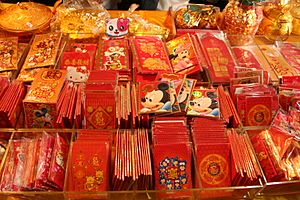
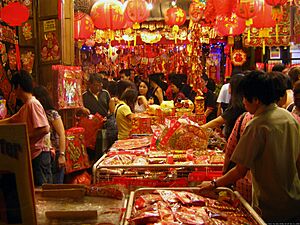
Red envelopes, also called red packets (traditional Chinese: 紅包; simplified Chinese: 红包), are given out during Chinese New Year. Married couples or older people give them to unmarried younger people or children. These red packets are also known as yasuiqian (压岁钱; 壓歲錢; yāsuìqián), which means "money to suppress evil spirits."
An old story says that a demon named Sui would touch sleeping children's heads on New Year's Eve, making them sick. Parents wrapped coins in red paper and put them under their children's pillows. The coins' flash scared Sui away. Since then, parents have given red packets to protect their children.
Red packets almost always contain money, from a few dollars to hundreds. Chinese traditions prefer amounts that are even numbers, like 8 (which sounds like "wealth") or 6 (which sounds like "smooth"). The number 4 is avoided because it sounds like "death." Odd numbers are also avoided. It is customary to use new bills inside the red envelope.
Asking for red packets is not usually turned down by married people, as it might mean bad luck for them. Children are expected to wish elders a happy new year before taking the red envelope. Red envelopes are often kept under the pillow for seven nights after New Year before being opened, as this symbolizes good luck.
In recent years, Chinese messaging apps like WeChat have made it popular to send virtual red envelopes using mobile payments, especially in group chats.
Gift Exchange
Besides red envelopes, small gifts like food or sweets are exchanged between friends and relatives from different homes. These gifts are often brought when visiting. Common gifts include fruits (especially oranges, but never pears), cakes, biscuits, chocolates, and candies. Gifts are usually wrapped in red or gold paper for good luck.
Some items are considered unlucky to give as gifts:
- Things related to funerals (like handkerchiefs, towels, white or black items).
- Items that suggest time is running out (like clocks or watches).
- Sharp objects that symbolize cutting ties (like scissors or knives).
- Items that sound like unpleasant words (for example, "pear" sounds like "separate").
Markets
Special markets or village fairs are set up as New Year approaches. These outdoor markets sell New Year items like flowers, toys, clothes, and even fireworks. They make it easy for people to buy gifts and decorations. In some places, choosing the perfect plum tree is similar to how Westerners choose a Christmas tree.
Fireworks
In ancient China, bamboo stems filled with gunpowder were burned to make loud noises and scare away evil spirits. Over time, this became the use of firecrackers. Firecrackers are usually strung together with a long fuse. Each firecracker is wrapped in red paper, as red is a lucky color. When lit, they make loud popping noises that are thought to scare away evil spirits. Firecrackers also show that it is a joyful time. However, since the 2000s, firecrackers have been banned in many cities and countries due to safety concerns.
Music
"Happy New Year!" (Chinese: 新年好呀; pinyin: Xīn Nián Hǎo Ya) is a popular children's song for the New Year holiday. Its tune is similar to the American folk song, Oh My Darling, Clementine. Another popular Chinese New Year song is Gong Xi Gong Xi (Chinese: 恭喜恭喜!; pinyin: Gongxi Gongxi!).
Movies
Watching Chinese New Year films is a way to celebrate Chinese culture. During the New Year holidays, many people watch these movies. In mainland China, the New Year's Gala is shown on TV, featuring traditional performances and messages. Hong Kong filmmakers also release comedies around this time.
Clothing
The color red is commonly worn during Chinese New Year. Traditional beliefs say that red can scare away evil spirits. Wearing new clothes is another custom, symbolizing a new beginning for the year.
Family Portrait
In some places, taking a family portrait is an important tradition after relatives gather. The photo is often taken in the main hall of the house or in front of it, with the oldest male family member sitting in the center.
Symbolism
Chinese New Year traditions include many symbols with deeper meanings. One common symbol is the red, diamond-shaped fu characters (Chinese: 福; pinyin: fú; Cantonese Yale: fūk; lit. 'blessings, happiness'), which are hung on the entrances of Chinese homes. This sign is often hung upside down. This is because the Chinese word for "upside down" (倒; dào) sounds like the word for "arrive" (到; dào). So, it means that luck, happiness, and prosperity are "arriving." However, in Cantonese-speaking areas, hanging it upside down can sound like "pouring luck away," so it's usually not done there.
Red is the main color used in New Year celebrations. Red means joy and also symbolizes goodness, truth, and honesty. Many New Year items, like candies, cakes, and decorations, are red. The Chinese word for "red" (pinyin: hóng; Cantonese Yale: húng) sounds like the word for "prosperous," making it a lucky color.
Nianhua
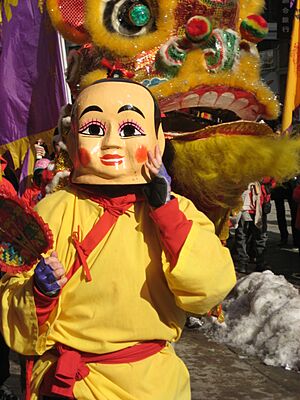
Nianhua are a type of Chinese colored woodblock print used for decoration during Chinese New Year. They show various subjects like nature, religion, and folklore in bright, lively ways to bring good luck for the new year.
Leisure
During Chinese New Year, work often stops at most places. A popular pastime is playing Mahjong with family or friends.
Flowers
Many flowers are popular decorations for the New Year and are sold at markets:
| Floral Decor | Meaning |
|---|---|
| Plum Blossom | symbolizes luck |
| Kumquat | symbolizes prosperity |
| Calamondin | symbolizes luck |
| Narcissus | symbolizes prosperity |
| Bamboo | its strength represents strong character |
| Sunflower | means to have a good year |
| Eggplant | a plant believed to heal sicknesses |
| Chom Mon Plant | a plant that brings tranquility |
| Orchid | represents fertility, abundance, beauty, and good taste |
| Phalaenopsis | symbolizes wealth, good luck, and a flourishing family and career |
Each flower has a special meaning. Many Chinese people believe that these flowers can bring the good things they represent. Generally, chrysanthemums are not kept at home during New Year, as they are usually used for ancestral veneration.
Icons and Ornaments
| Icons | Meaning | Illustrations |
|---|---|---|
| Lanterns | These red, often oval-shaped lanterns are traditional Chinese paper lanterns. The bright, colorful lanterns used on the fifteenth day for the Lantern Festival come in many sizes and shapes. | |
| Decoration | Decorations often share New Year greetings. Faichun, which are auspicious Chinese sayings written in calligraphy on red posters, are hung on doorways and walls. Other decorations include New year pictures, Chinese knots, Sycee, papercutting, and couplets. | |
| Dragon dance and Lion dance | Dragon and lion dances are common. The loud drums, cymbals, and aggressive dancing are believed to scare away bad spirits. Lion dances are also popular for business openings. | 
|
| Fu Lu Shou | Nianhua (New Year pictures) of the Fu Lu Shou, who are gods of good fortune, prosperity, and longevity. | |
| Red envelope | Given to children, elders, and performers while saying good wishes like "Gong Xi Fa Cai." | |
| Shrubs | Citrus trees are often used for decoration. |
Spring Travel
Traditionally, families gather for Chinese New Year. In modern China, many people who work away from home travel back to have reunion dinners with their families. Because so many people travel, special arrangements are made for trains, buses, and airlines starting 15 days before New Year's Day. This 40-day period is called chunyun, and it is known as the world's largest yearly migration. More trips are taken in China during this time than the total population of China.
Celebrations Outside China
Chinese New Year is celebrated every year in many countries with large Chinese populations. These include countries in Asia, Oceania, and North America. Sydney, London, and San Francisco claim to have some of the biggest New Year celebrations outside of Asia. Australia hosts the largest Chinese New Year celebration in the Southern Hemisphere.
East Asia
Korea
Seollal (Korean: 설날; RR: Seollal) is a Korean traditional festival and national holiday. It celebrates the first day of the lunisolar calendar. It is one of the most important holidays for Koreans, celebrated in both North and South Korea, and by Koreans living around the world. During this time, many Koreans visit family, perform ancestor rituals, wear traditional clothes called hanbok, eat traditional food, and play folk games. A well-known tradition is receiving money from elders after performing a formal bow.
Japan
The Japanese New Year (正月, Shōgatsu) is an annual festival in Japan. Since 1873, the official Japanese New Year has been celebrated on January 1st of the Gregorian calendar. Before 1872, Japanese New Year was based on Japanese versions of the lunisolar calendar, similar to the Chinese calendar. However, after the Meiji Restoration, Japan adopted the Gregorian calendar.
Taiwan
In Taiwan, Chinese New Year is most commonly called Chinese: 農曆新年; pinyin: Nónglì Xīnnián (Agricultural Calendar New Year) or simply Chinese: 過年; pinyin: Guònián (passing year). Unlike in China, where "Spring Festival" is the official term, people in Taiwan usually do not use that name in daily talks. They focus on the connection to the traditional Chinese calendar.
Taiwanese Guonian has some different customs from China's Spring Festival. In Taiwan, Chinese New Year emphasizes honoring ancestors with special rituals, including offering food and incense at home altars. Taiwanese families often enjoy local foods like pineapple cakes and Kuihs, which symbolize good fortune. While fireworks are popular, Taiwan focuses more on temple visits, lantern-lighting, and family reunions.
In Taiwan, businesses traditionally reopen on the sixth day of Chinese New Year with firecrackers. On the morning of the ninth day, Taiwanese households set up an altar with offerings to honor the Jade Emperor. They kneel and bow to show respect and wish him a long life.
Southeast Asia
Chinese New Year is a national public holiday in many Southeast Asian countries and is one of the most important holidays of the year.
Malaysia
Chinese New Year's Eve is usually a half-day holiday in Malaysia, and Chinese New Year itself is a two-day public holiday. George Town, a city with many Chinese residents, is known for its lively Chinese New Year celebrations that last until the Lantern Festival. Kek Lok Si, Malaysia's largest Buddhist temple, is usually lit up during the festivities. The Penang's Chief Minister often hosts an "open house" for the public. Many other events happen across the city. Hokkien families celebrate the Jade Emperor's Birthday on the ninth day with offerings. During the Lantern Festival, single women traditionally throw oranges into the sea, hoping to find a partner.
Singapore

In Singapore, Chinese New Year is a two-day public holiday. There are many festive activities, especially in Chinatown. These include street markets, nightly shows, and lion dance competitions. The Chingay Parade, a colorful street parade with floats and cultural performances, is also a big part of the celebrations.
Indonesia
In Indonesia, Chinese New Year is called Tahun Baru Imlek. It was an official national holiday for a few years in the mid-20th century. From 1967 to 1998, celebrating Chinese New Year was restricted to inside Chinese homes. This changed in 2000, and it became a public holiday again in 2002.

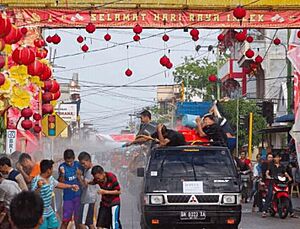
In Indonesia, the first day of Chinese New Year is a national holiday. Cities with many Chinese people, like Jakarta and Medan, celebrate with parades and fireworks. Shopping malls decorate with lanterns. Lion dances are common in neighborhoods, temples, and malls. Many Buddhists, Confucians, and Taoists burn incense as prayers. Chinese temples are often open for 24 hours on the first day, giving out red envelopes and food to those in need.
Philippines

In the Philippines, Chinese New Year is an important festival for Chinese Filipinos. Since 2012, it has been a public non-working holiday for everyone. Selling or giving Tikoy (a type of New Year cake) is a common practice. Celebrations are mainly in Binondo in Manila, the world's oldest Chinatown, and other major cities.
In 2024, Manila celebrated the Spring Festival of the Wooden Dragon, including the 430th anniversary of Manila Chinatown. There was a parade and a midnight fireworks show. In Cebu, a festival called the Red Lantern Festival is held.
Thailand
Chinese New Year celebrations happen across Thailand, especially in provinces with many Chinese people. The festival is usually celebrated for three days. The first day is for shopping for offerings, the second day is for worshipping gods and ancestors, and the third day is a holiday for visiting relatives and friends. People often wear red clothes for good luck.
In Bangkok, there are big celebrations in Chinatown, Yaowarat Road. The main road is closed and becomes a walking street, and a member of the royal family often attends to open the ceremony.
Australia and New Zealand
Sydney has one of the largest Chinese populations outside of Asia and hosts huge Chinese New Year celebrations, attracting over 600,000 people. The events last over three weeks and include markets, food stalls, opera, dragon boat races, a film festival, and parades. The main parade has over 3,500 performers and draws more than 100,000 viewers. Other Australian cities like Brisbane, Melbourne, and Perth also celebrate with lion dances, dragon dances, and food festivals.
In New Zealand, Auckland hosts the Auckland Lantern Festival. Wellington has a two-day festival, and Dunedin holds a one-day festival centered in its Chinese gardens.
North America
Many cities in North America have official Chinese New Year parades. These include New York City, San Francisco, Los Angeles, Boston, Chicago, Toronto, and Vancouver. Even smaller cities with historical Chinese connections, like Butte, Montana, have recently hosted parades.
New York City
Different groups in New York City work together to host a week-long Chinese New Year celebration. This includes cultural festivals and special exhibits. A key event is the Chinese New Year parade with floats and fireworks in Chinatown, Manhattan, which is the largest Chinese New Year parade outside Asia. In 2015, New York City made Lunar New Year a public school holiday.
California
In 2022, California declared Lunar New Year a state government holiday, effective from 2023. Many communities across California celebrate with large events in the Bay Area and Greater Los Angeles, as well as in cities like Fresno and Sacramento.
San Francisco
The San Francisco Chinese New Year Festival and Parade is one of the oldest and largest events of its kind outside of Asia. It is also one of the biggest Asian cultural events in North America.
The festival uses Grant and Kearny Streets for its street festival and parade. This tradition goes back to early parades in San Francisco. In the 1860s, residents of San Francisco's Chinatown wanted to share their culture. They invited other groups to join, and they marched with colorful flags, lanterns, drums, and firecrackers to scare away evil spirits.
In San Francisco, over 100 groups take part in the annual Chinese New Year Parade, which has been held since 1958. About 500,000 people watch the parade in person, and millions more watch on TV.
Greater Los Angeles
The Golden Dragon Parade has been held annually in Chinatown Los Angeles since 1899. It is one of the oldest and largest Chinese New Year parades outside of Asia. Starting in the 1970s, famous Asian American actors, like Bruce Lee, have been Grand Marshals of the parade.
Around Southern California, many communities also hold festivals and parades that can last several days. Some of the biggest happen in the San Gabriel Valley, which has the largest Chinese community outside of Asia. Monterey Park hosts the largest festival, covering five city blocks and attracting over 100,000 people.
Disneyland California Adventure in Anaheim celebrates Chinese New Year by decorating parts of the park, serving special East Asian foods, and offering character photos with Mulan, Mickey, and Minnie Mouse in Chinese costumes.
Europe
United Kingdom
In London, celebrations take place in Chinatown, Leicester Square, and Trafalgar Square. Festivities include a parade, cultural food, fireworks, concerts, and performances. Organizers say the celebration attracts between 300,000 and 500,000 people each year.
France
In Paris, celebrations have been held since the 1980s in several districts for about a month. There are many performances, and the main parade has 40 groups and 4,000 performers, attracting over 200,000 people in the 13th arrondissement.
Netherlands
Official celebrations have been held in The Hague, Amsterdam, and Rotterdam.
Hungary
In Budapest, celebrations have been held since 2017 in the Kőbánya district, with many performances and parades.
India and Pakistan
Many people celebrate the festival in Chinatown, Kolkata, India, where a large community of Chinese origin lives. In Kolkata, Chinese New Year is celebrated with lion and dragon dances.
In Pakistan, Chinese New Year is also celebrated by the large Chinese expatriate community. The Chinese embassy in Islamabad organizes cultural events, with Pakistani arts and cultural groups also taking part.
Mauritius
Chinese culture in Mauritius is an important part of the island's many cultures. Even though the Sino-Mauritian community is small (about 3% of the population), Chinese New Year is a time when Chinese culture is celebrated, and it is a public holiday in Mauritius. Mauritius is the only country in Africa that lists the Chinese Spring Festival as a public holiday. During this time, there is a joyful and festive mood across the country.
Sino-Mauritians follow Chinese traditions closely. The Chinese Spring Festival is their biggest celebration. The dates follow the Chinese lunisolar calendar. In the week before New Year's Day, homes are spring-cleaned. The festival starts on Chinese New Year's Eve by lighting firecrackers to scare away evil spirits. Traditionalists visit pagodas to offer prayers. There is a big family dinner on New Year's Eve. While traditionally held at the oldest parents' home, going to restaurants for New Year's Eve is becoming more popular. After dinner, young people often go to nightclubs. On Chinese New Year's Day, it is customary to share niangao with relatives and friends and to light firecrackers. Red envelopes are also given. Some families visit pagodas to honor ancestors or eat a vegetarian meal. The main celebrations usually happen in the Chinatown area in Port Louis, the capital of Mauritius. The Dragon dance and Southern Lion dance are also customary. The color red is used a lot to decorate streets and houses.
Greetings and Wishes
Chinese New Year is often celebrated with loud, happy greetings, called auspicious words or phrases. New Year couplets, printed in gold letters on bright red paper, are hung on doorways and walls. These are called chunlian (Chinese: hant) or fai chun (Chinese: hant). They have been around for a long time and are now seen everywhere during Chinese New Year.
Some common greetings include:
- Xin nian kuai le / San nin fai lok: simplified Chinese: 新年快乐; traditional Chinese: 新年快樂; pinyin: Xīnniánkuàilè; Jyutping: san1 nin4 faai3 lok6; Pe̍h-ōe-jī: Sin-nî khòai-lo̍k. This means "Happy new year." In northern China, people often say simplified Chinese: 过年好; traditional Chinese: 過年好; pinyin: Guònián Hǎo instead, which can be used for the first five days of New Year.
- Gong xi fa cai / Gong hei fat choi: simplified Chinese: 恭喜发财; traditional Chinese: 恭喜發財; pinyin: Gōngxǐfācái. This means "Congratulations and be prosperous." It is often mistakenly thought to mean "Happy New Year." This saying is common in English-speaking areas with many Chinese people.
Many other greetings exist. For example, if something breaks during New Year, which is considered unlucky, one might immediately say 歲歲平安 (Suìsuì-píng'ān), meaning "everlasting peace year after year." The word Suì (歲), meaning "age," sounds like 碎 (suì), meaning "shatter," showing how Chinese people use wordplay for good luck. Similarly, 年年有餘 (niánnián yǒu yú), a wish for "surpluses every year," plays on the word yú, which also means "fish."
Most common lucky greetings have four characters, such as:
- 金玉滿堂, Jīnyùmǎntáng – "May your wealth [gold and jade] come to fill a hall."
- 大展鴻圖, Dàzhǎnhóngtú – "May you achieve your big goals."
- 迎春接福, Yíngchúnjiēfú – "Greet the New Year and find happiness."
- 萬事如意, Wànshìrúyì – "May all your wishes come true."
- 吉慶有餘, Jíqìngyǒuyú – "May your happiness be endless."
- 竹報平安, Zhúbàopíng'ān – "May you hear that all is well."
- 一本萬利, Yīběnwànlì – "May a small investment bring huge profits."
- 福壽雙全, Fúshòushuāngquán – "May you have complete happiness and a long life."
- 招財進寶, Zhāocáijìnbǎo – "When wealth is gained, precious things follow."
These greetings are used when receiving red packets, exchanging gifts, visiting temples, or even when tossing the ingredients of yusheng salad. Children and parents might also pray in temples for good blessings.
Children and teenagers sometimes jokingly say, "恭喜發財,紅包拿來" (pinyin: gōngxǐfācái, hóngbāo nálái), which means "Congratulations and be prosperous, now give me a red envelope!"
|
Fun Facts About Chinese New Year
- About 1/4 of the world's people celebrate Chinese New Year.
- San Francisco has celebrated Chinese New Year since the 1860s. It claims its Chinese New Year parade is the biggest celebration outside of Asia.
- People try to eat as many dumplings as they can. Dumplings represent wealth.
- Giving pears as a gift is considered rude. The Chinese word for pears (梨 lí) sounds like the word for leaving or parting (离 lí).
- In China, females are said to be ready for marriage up to age 30, and males before 32. Because of this, some people rent a boyfriend or girlfriend for Chinese New Year. This makes visiting their families easier.
- An old Chinese belief says the second day of the new year is the birthday of all dogs. People should be extra kind to dogs that day.
- According to Chinese tradition, whatever someone does on New Year’s Day sets the example for the rest of the year.
- Chinese supermarkets report that sales of adult diapers go up by 50% during the Chinese New Year traveling season.
See also
 In Spanish: Año Nuevo chino para niños
In Spanish: Año Nuevo chino para niños


